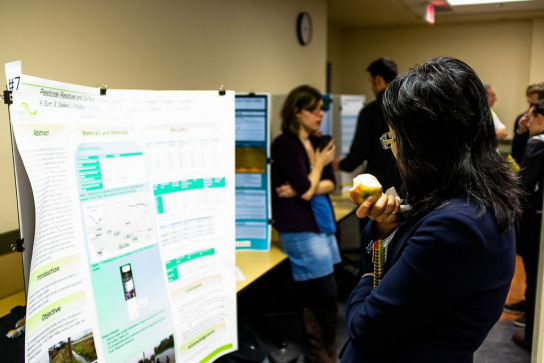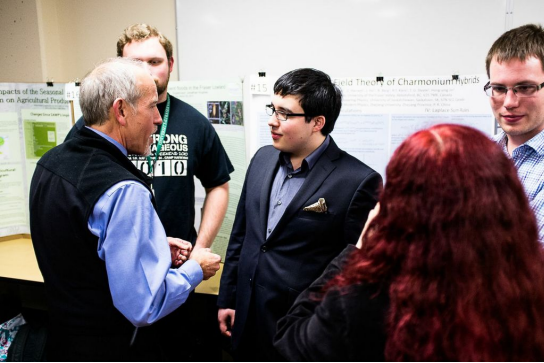Print Edition: March 27, 2013
Ever wonder what to do with all the skills gained in the first couple of years of your degree?
Student Research Day gives students an opportunity to showcase the skills and research they have gained through individual or group research projects. This year, over 40 students participated in Student Research Day, either through five-minute microlectures or poster presentations.
The lectures are designed for students to get experience in communicating their research to a room that is unfamiliar with the project. The posters are displayed and judged, with awards given based on the criteria of readability, impact, importance of research, visual appeal, organization of material, effort in poster construction and presenter’s knowledge and enthusiasm.
Now in its 10th year, Student Research Day is a chance for students to convey the passion behind the research – and show off the work that they’ve done.
Five-minute pitch: making sense of micro-lectures
Students passing by the Road Runner Cafe on the first floor of A building couldn’t help but listen as 11 different research projects were presented.
The presentation kicked off at 11:30 a.m. with an introduction from director of research and industry liaison Brad Whittaker. He explained the rules—five minutes to explain who you were and why you were there—and thanked those involved with the coordination of the event, including Yvette Fairweather and Deborah Block of the research and graduate studies department.
UFV president Mark Evered was also on hand, and he enthusiastically commended the student researchers for their dedication and passion for their projects, speaking to the necessity for ongoing research on university campuses.
“Research really is a defining characteristic of universities. It’s what differentiates us from a lot of other kinds of post-secondary institutions,” he said. “Research and scholarship takes us to the frontiers of knowledge that is really the place that we want to take all of our students.”
Students from biology, criminology, geography, kinesiology and physical education (KPE), media and communications studies (MACS), physics and psychology presented their research, each one balancing theory and research methods with relevance and enthusiasm.
KPE student Scott Bishop, connected his research on heart rate variabilities with concussion injuries to NHL’s Sydney Crosby, and MACS student Ali Siemens connected privacy issues in online society to Facebook. Physics major Jason Ho assured the audience that he would make his research into quantum field theory accessible.
“Before anybody panics out there, let me just put you at ease,” he said in his address to the crowd. “There’s not going to be any squiggly diagrams or Greek letters. I want to try and give you a feel for what’s going on in the physics department … without any of that mathematical mumbo jumbo.”
Whittaker congratulated the students for their hard work and humorously alluded to next year’s faculty microlectures, saying that the bar has been set high for them.
“It’s just fascinating to hear what students are capable of, especially undergrad students,” he concluded.
Research and awards: student poster presentations
The second part of Student Research Day began later in the afternoon with nearly 30 posters presenting a wide range of student research projects.
The posters ranged from biology to media studies, stopping at all of the sciences and some of the humanities on the way. There was also a class of Communications 155 posters that were not included in the competition portion of the event.
The poster projects were judged by seven members of the faculty on a volunteer basis. Generally they judge inside their own faculties, but as one judge for the faculty of science commented, there was some crossover this year – she found herself judging posters inside the social sciences.
Student Alan Sum presented two biology posters: one compared fungi between organic and conventional blueberry farms, and the other looked at pesticide residue and surface water quality in the lower Fraser Valley.
Like Sum’s research, the majority of posters focused on topics relevant to the community and its residents, something that Evered commented as being a strength of their research.
“I’m so impressed … not only with the quality of the research that the students are doing but their wonderful ability to communicate what they’re doing,” he said. “Whether it’s science, social science [or] humanities, there’s relevance to the world in which we’re living.”
Sum wasn’t the only student to present two posters. social, cultural and media studies (SCMS) student Julia Hodgins presented a poster that looked at the present state of norms and values inside society, and another that focused on the relationship between children’s self esteem and poverty.
She admitted that jumping between two posters and two judges was a challenge, but doesn’t know why more students don’t participate in Student Research Day.
Behind the scenes: the result and future of Student Research Day
Biology instructor and Student Research Day coordinator Ron Wilen spoke to the result of this year’s event.
“It has grown pretty much every year until this year and we have seen a small decline this year,” he explained.
Research projects from any discipline are eligible for presentation on Student Research Day, but this year the primary representation came from sciences and geography.
“In the past we’ve had history, we’ve had psychology projects, we’ve had English projects, anthropology projects,” Wilen explained. “The number of science students was about the same as previous years, and on the social studies side it’s mostly geography students. Again, those numbers were about constant. It is the other faculties that we just didn’t see the students this year that we normally would.”
Wilen noted that the decline was due to two factors: an earlier date resulted in single-semester projects being less developed than in previous years, and the fact that several faculty members (who usually oversee these kinds of projects) were on sabbatical.
Student Research Day may take on a new form in future years. At a recent meeting Wilen explained that there was discussion of combining the event with an open house for new students. This would foster an interest in research earlier in a student’s university career.
Location is also something that might change in the future; the poster presentations were held in B121, and the room filled up quickly.
“It was pretty crowded in there,” Wilen explained. “I have suggested we go to Chilliwack because we have that big foyer … it’s a huge space and we would get lots of flow-through traffic.”
Apart from serving as a valuable learning opportunity for students to gain experience in presenting their research, Student Research Day also functions to bolster an interest for research in other students that happen to pass by the event.
“It exposes those students to the idea that, ‘Oh, I can do research as I progress through UFV,’” Wilen explained. “That is the other major function that research day has, is that it exposes non-participating students to that possibility.”



